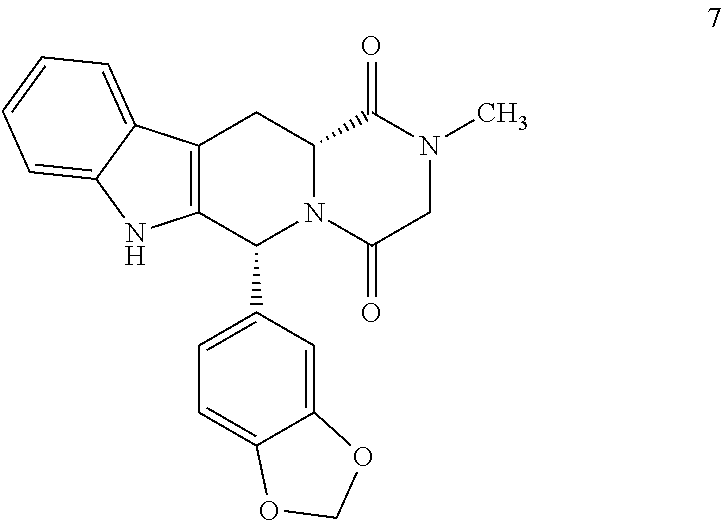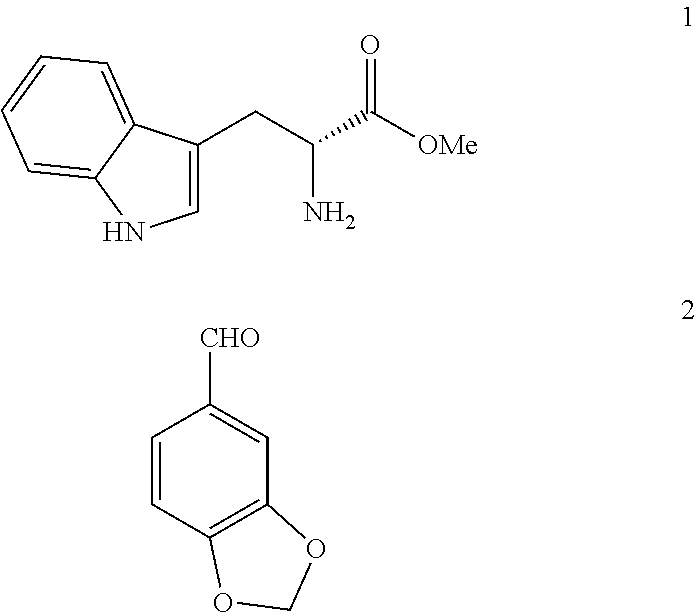Process for obtaining compounds derived from tetrahydro-.beta.-carboline
a technology of tetrahydro beta .carboline and compound, which is applied in the field of process for obtaining compounds derived from tetrahydro beta .carboline, can solve the problem of a considerable period of time required
- Summary
- Abstract
- Description
- Claims
- Application Information
AI Technical Summary
Benefits of technology
Problems solved by technology
Method used
Image
Examples
example 1
Production of methyl(1R,3R)-1-(3,4-methylenedioxyphenyl)-2,3,4,9-tetrahydro-9H-pyrido[3,4-b]-indol-3-carboxylate(3cisHCl)
[0045]50 g (0.3 mol) of piperonal (2) were heated to 110° C. 21.2 g (0.08 mol) of D-tryptophan methyl ester hydrochloride (1HCl) were added. The suspension was stirred for 15 minutes (min) at 110° C. A paste is formed that was allowed to cool to 70° C. and 210 ml of acetonitrile (ACN) were added. It was stirred for 1 h at 20-25° C. The solid was filtered, washed with 50 ml of ACN and dried under vacuum at 50° C. This produces 29.6 g of 3cisHCl (92% yield). HPLC Purity: 94% (3% trans isomer). Melting point 220° C. 1H NMR (400 MHz, DMSO) δ 10.83 (s, 1H), 10.78 (s, 1H), 10.34 (s, 1H), 7.53 (d, j=7.7 Hz, 1H), 7.30 (d, j=8.0 Hz, 1H), 7.18-6.98 (m, 5H), 6.10 (s, 2H), 5.88 (s, 1H), 4.70 (s, 1H), 3.83 (s, 3H), 3.34 (d, j=8.0 Hz, 2H). IR (KBr) vmax 3399, 3207, 3058, 3030, 2961, 2913, 2636, 2525, 2423, 2391, 1743, 1493, 1259, 1041, 746 cm−1.
example 2
Production of methyl(1R,3R)-1-(3,4-methylenedioxyphenyl)-2-chloroacetyl-2,3,4,9-tetrahydro-9H-pyrido[3,4-b]indol-3-carboxylate (5cis)
a) Starting from D-tryptophan methyl ester hydrochloride (1HCl)
[0046]100 g (0.67 mol) of piperonal (2) were heated to 120° C. 42.4 g (0.17 mol) of D-tryptophan methyl ester hydrochloride (1HCl) were added. The suspension was stirred for 30 min at 120° C. It was allowed to cool to 20-25° C. 380 ml of DCM were added. It was cooled to 0-5° C. and under a N2 atmosphere, 56.8 ml of triethylamine (0.4 mol) were added dropwise (15 min). It was stirred at 0-5° C. for 15 min. 16 ml of chloroacetyl chloride (0.2 mol) were added dropwise (30 min) in 38 ml of DCM. It was stirred at 0-5° C. for 30 min. It was left to react at room temperature. 1272 ml of DCM were added. It is first extracted with deionised water (794 ml), and then with a saturated solution of NaHCO3 (1272 ml) and finally with a saturated solution of NaCl (1590 ml). The organic phase was dried with ...
example 3
Production of (6R,12R)-2,3,6,7,12,12a-hexahydro-2-methyl-6-(3,4-methylenedioxyphenyl)-pyrazino[2′,1′:6,1]pyrido[3,4-b]indol-1,4-dione (7)
[0049]0.5 g of carboline chloroacetyl 5cis were dissolved in 2.5 ml of THF. 0.45 g of a 40% methylamine solution in water were added dropwise at 25° C. and under a N2 atmosphere. It was heated to 55° C. stirred for 1 h. It was cooled to 0-5° C. and 3 ml of a 2:1 IPA / water mixture were added. Concentrated HCl was added until reaching an acid pH. The THF was distilled, cooled to 0-5° C. and 1.5 ml of IPA and 0.5 ml of water were added. It was stirred at 0-5° C. for 2 h. It was filtered and the solid obtained washed with a cold 1:1 mixture of IPA / water and dried under vacuum at 50° C. This produced 0.35 g of 7 (77% yield). HPLC Purity: 99.6%. Melting point 293° C. 1H NMR (400 MHz, DMSO) δ 11.03 (s, 1H), 7.55 (d, j=7.7 Hz, 1H), 7.31 (d, j=7.9 Hz, 1H), 7.06 (t, j=7.3 Hz, 1H), 7.00 (t, j=7.3 Hz, 1H), 6.88 (s, 1H), 6.83-6.73 (m, 2H), 6.15 (s, 1H), 5.92 (s...
PUM
| Property | Measurement | Unit |
|---|---|---|
| temperature | aaaaa | aaaaa |
| temperature | aaaaa | aaaaa |
| reaction temperature | aaaaa | aaaaa |
Abstract
Description
Claims
Application Information
 Login to View More
Login to View More - R&D
- Intellectual Property
- Life Sciences
- Materials
- Tech Scout
- Unparalleled Data Quality
- Higher Quality Content
- 60% Fewer Hallucinations
Browse by: Latest US Patents, China's latest patents, Technical Efficacy Thesaurus, Application Domain, Technology Topic, Popular Technical Reports.
© 2025 PatSnap. All rights reserved.Legal|Privacy policy|Modern Slavery Act Transparency Statement|Sitemap|About US| Contact US: help@patsnap.com



